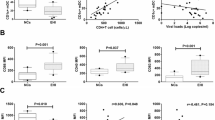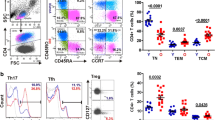Abstract
Antigen presenting dendritic cells (DCs) can serve as sites for HIV replication and as vehicles for transmission of the virus to T cells. It is known that the numbers of DCs in blood is reduced during HIV-1 infection. Here we monitored the two major subsets of blood DCs in 12 individuals undergoing a change, primarily initiation, of highly active antiretroviral therapy. The numbers of plasmacytoid DCs were reliably higher on therapy, although in the 1–3 month interval we followed, these numbers did not return to those seen in HIV uninfected controls. An increase in plasmacytoid DCs was accompanied by an increase in IFN-α production in response to a standard challenge in culture with UV-inactivated herpes simplex virus. The levels of myeloid DCs also demonstrated an increase while on HAART, and these numbers become comparable to the HIV uninfected controls. The numbers of plasmacytoid and myeloid DCs varied inversely with the levels of plasma HIV viremia. These longitudinal studies extend prior work showing that virus infection with HIV leads to a decrease in the number of dendritic cells in blood, and that this can be reversed at least in part by therapy.
Similar content being viewed by others
References
Donaghy H, Pozniak A, Gazzard B, Qazi N, Gilmour J, Gotch F, Patterson S: Loss of blood CD11c (+) myeloid CD11c (−) plasmacytoid dendritic cells in patients with HIV-1 infection correlates with HIV-1 RNA virus load. Blood98:2574–2576, 2001
Banchereau J, Steinman RM: Dendritic cells and the control of immunity. Nature392:245–252, 1998
Hart DNJ: Dendritic cells: Unique leukocyte populations which control the primary immune response. Blood90:3245–3287, 1997
Austyn JM: Dendritic cells. Curr Opin Hematol5:3–15, 1998
Chehimi J, Campbell DE, Azzoni L, Bacheller D, Papasavvas E, Jerandi G, Mounzer K, Kostman J, Trinchieri G, Montaner LJ: Persistent decreases in blood plasmacytoid dendritic cell number and function despite effective highly active antiretroviral therapy and increased blood myeloid dendritic cells in HIV-infected individuals. J Immunol168:4796–4801, 2002
Banchereau J, Briere F, Caux C, Davoust J, Lebecque S, Liu Y-J, Pulendran B, Palucka K: Immunobiology of dendritic cells. Annu Rev Immunol18:767–811, 2000
Perussia B, Fanning V, Trinchieri G: A leukocyte subset bearing HLA-DR antigen is responsible for in vitro alpha interferon production in response to viruses. Nat Immun Cell Growth Regul4:120–126, 1984
Siegal FP, Kadowaki N, Shodell M, Fitzgerald-Bocarsly PA, Shah K, Ho S, Antonenko S, Liu YJ: The nature of the principal type 1 interferon-producing cells in human blood. Science284:1835–1837, 1999
Chehimi J, Starr SE, Kawashima H, Miller DS, Trinchieri G, Perussia B, Bandyopadhyay S: Dendritic cells and IFN-alpha-producing cells are two functionally distinct non-B, non-monocytic HLA-DR+ cell subsets in human peripheral blood. Immunology68:488–490, 1989
Lopez CB, Garcia-Sastre A, Williams BRG, Moran TM: Type 1 interferon induction pathway, but not released interferon, participates in the maturation of dendritic cells induced by negative-strand RNA viruses. J Infect Dis187:1126–1136, 2003
Diebold SS, Montoya M, Unger H, Alexopoulou L, Roy P, Haswell LE, Al-Shamkhani A, Flavell R, Borrow P, Reis e Sousa C: Viral infection switches non-plasmacytoid dendritic cells into high interferon producers. Nature424:324–328, 2003
Siegal FP, Lopez C, Fitzgerald PA, Shah K, Baron P, Leiderman IZ, Imperato D, Landesman S: Opportunistic infections in acquired immune deficiency syndrome result from synergistic defects of both the natural and adaptive components of cellular immunity. J Clin Invest78:115–123, 1986
Siegal FP, Fitzgerald-Bocarsly P, Holland BK, Shodell M: Interferon-alpha generation and immune reconstitution during antiretroviral therapy for human immunodeficiency virus infection. Aids15:1603–1612, 2001
Lopez C, Fitzgerald PA, Siegal FP: Severe acquired immune deficiency syndrome in male homosexuals: Diminished capacity to make interferon-alpha in vitro associated with severe opportunistic infections. J Infect Dis148:962–966, 1983
Lopez C, Fitzgerald PA, Siegal FP, Landesman S, Gold J, Krown SE: Deficiency of interferon-alpha generating capacity is associated with susceptibility to opportunistic infections in patients with AIDS. Ann NY Acad Sci437:39–48, 1984
Soumelis V, Scott I, Gheyas F, Bouhour D, Cozon G, Cotte L, Huang L, Levy JA, Liu YJ: Depletion of circulating natural type 1 interferon-producing cells in HIV-infected AIDS patients. Blood98:906–912, 2001
Ferbas J, Navratil J, Logar A, Rinaldo C: Selective decrease in human immunodeficiency virus type 1 (HIV-1)-induced alpha interferon production by peripheral blood mononuclear cells during HIV-1 infection. Clin Diagn Lab Immunol2:138–142, 1995
Shirazi Y, Pitha PM: Alpha interferon inhibits early stages of the human immunodeficiency virus type 1 replication cycle. J Virol66:1321–1328, 1992
Pitha PM: Multiple effects of interferon on the replication of human immunodeficiency virus type 1. Antiviral Res 24:205–219, 1994
Portales P, Reynes J, Pinet V, Rouzier-Panis R, Baillat V, Clot J, Corbeau P: Interferon-alpha restores HIV-induced alteration of natural killer cell perforin expression in vivo. Aids17:495–504, 2003
Soumelis V, Scott I, Liu YJ, Levy J: Natural type 1 interferon producing cells in HIV infection. Hum Immunol 63:1206–1212, 2002
Loubeau M, Ahmad A, Toma E, Menezes J: Enhancement of natural killer and antibody-dependent cytolytic activities of the peripheral blood mononuclear cells of HIV-infected patients by recombinant IL-15. J Acquir Immune Defic Syndr Hum Retrovirol16:137–145, 1997
Lin SJ, Roberts RL, Ank BJ, Nguyen QH, Thomas EK, Stiehm ER: Effect of interleukin (IL)-12 and IL-15 on activated natural killer (ANK) and antibody-dependent cellular cytotoxicity (ADCC) in HIV infection. J Clin Immunol18:335–345, 1998
Naora H, Gougeon ML: Enhanced survival and potent expansion of the natural killer cell population of HIV-infected individuals by exogenous interleukin-15. Immunol Lett68:359–367, 1999
Mocroft A, Vella S, Benfield TL, Chiesi A, Miller V, Gargalianos P, d’Arminio Monforte A, Yust I, Bruun JN, Phillips AN, Lundgren JD: Changing patterns of mortality across Europe in patients infected with HIV-1. EuroSIDA Study Group. Lancet352:1725–1730, 1998
Palella FJ, Delaney KM, Moorman AC, Loveless MO, Fuhrer J, Satten GA, Aschman DJ, Holmberg SD, The HIV outpatient study investigators: Declining morbidity and mortality among patients with advanced human immunodeficiency virus infection. N Engl J Med338:853–860, 1998
Egger M, Hirschel B, Francioli P, Sudre P, Wirz M, Flepp M, Rickenbach M, Malinverni R, Vernazza P, Battegay M: Impact of new antiretroviral combination therapies in HIV infected patients in Switzerland: Prospective multicentre study. Swiss HIV Cohort Study. Bmj315:1194–1199, 1997
Ives NJ, Gazzard BG, Easterbrook PJ: The changing pattern of AIDS-defining illnesses with the introduction of highly active antiretroviral therapy (HAART) in a London clinic. J Infect42:134–139, 2001
Donaghy H, Gazzard B, Gotch F, Patterson S: Dysfunction and infection of freshly isolated blood myeloid and plasmacytoid dendritic cells in patients infected with HIV-1. Blood101:4505–4511, 2003
Pacanowski J, Kahi S, Baillet M, Lebon P, Deveau C, Goujard C, Meyer L, Oksenhendler E, Sinet M, Hosmalin A: Reduced blood CD123+ (lymphoid) and CD11c+ (myeloid) dendritic cell numbers in primary HIV-1 infection. Blood98:3016–3021, 2001
Barron MA, Blyveis N, Palmer BE, MaWhinney S, Wilson CC: Influence of plasma viremia on defects in number and immunophenotype of blood dendritic cell subsets in human immunodeficiency virus 1-infected individuals. J Infect Dis187:26–37, 2003
Shodell M, Siegal FP: Corticosteroids depress IFN-alpha-producing plasmacytoid dendritic cells in human blood. J Allergy Clin Immunol108:446–448, 2001
Author information
Authors and Affiliations
Corresponding author
Rights and permissions
About this article
Cite this article
FINKE, J.S., SHODELL, M., SHAH, K. et al. Dendritic Cell Numbers in the Blood of HIV-1 Infected Patients Before and After Changes in Antiretroviral Therapy. J Clin Immunol 24, 647–652 (2004). https://doi.org/10.1007/s10875-004-6250-5
Issue Date:
DOI: https://doi.org/10.1007/s10875-004-6250-5




